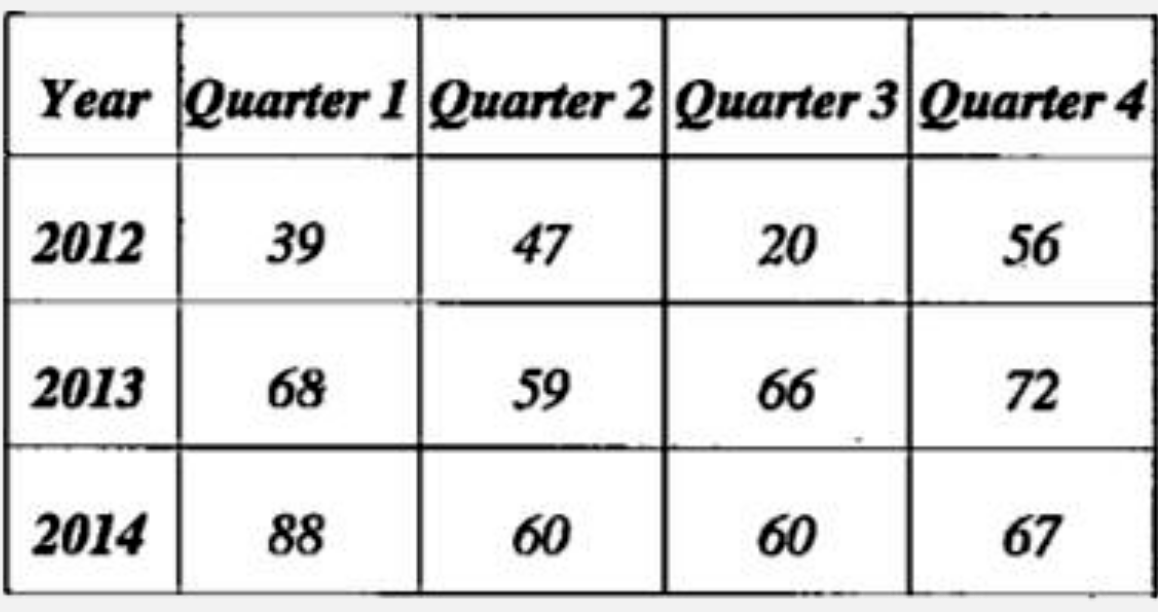Calculate the three -yearly moving averages and display these and the original figures on the same graph.
The correct Answer is:Trend values are : 36.7, 53.3, 66.7, 83.3 and 103.3
To calculate the three-yearly moving averages for the given data and display them along with the original figures, follow these steps:
Step 1: Organize the Data
We have the following data for the years 2001 to 2007:
| Year | Values |
|------|--------|
| 2001 | 20 |
| 2002 | 40 |
| 2003 | 50 |
| 2004 | 70 |
| 2005 | 80 |
| 2006 | 100 |
| 2007 | 130 |
Step 2: Calculate the Three-Yearly Moving Averages
To calculate the three-yearly moving averages, we will take the average of every three consecutive years.
1. For 2001, 2002, and 2003:
Moving Average=20+40+503=1103≈36.67
2. For 2002, 2003, and 2004:
Moving Average=40+50+703=1603≈53.33
3. For 2003, 2004, and 2005:
Moving Average=50+70+803=2003≈66.67
4. For 2004, 2005, and 2006:
Moving Average=70+80+1003=2503≈83.33
5. For 2005, 2006, and 2007:
Moving Average=80+100+1303=3103≈103.33
Step 3: Create a Table for Moving Averages
Now we can summarize the moving averages in a table:
| Year | Values | 3-Year Moving Average |
|------|--------|-----------------------|
| 2001 | 20 | |
| 2002 | 40 | 36.67 |
| 2003 | 50 | 53.33 |
| 2004 | 70 | 66.67 |
| 2005 | 80 | 83.33 |
| 2006 | 100 | 103.33 |
| 2007 | 130 | |
Step 4: Prepare the Graph
1. X-axis: Years (2001 to 2007)
2. Y-axis: Values (0 to 140)
3. Plot Original Values: Mark the points for the original values at their respective years.
4. Plot Moving Averages: Mark the points for the moving averages at 2002, 2003, 2004, 2005, and 2006.
5. Connect the Points: Draw lines to connect the points for both original values and moving averages.
Final Graph
The graph will display the original values and the three-year moving averages, allowing for a visual comparison of the trends over the years.
We have the following data for the years 2001 to 2007:
|------|--------|
| 2001 | 20 |
| 2002 | 40 |
| 2003 | 50 |
| 2004 | 70 |
| 2005 | 80 |
| 2006 | 100 |
| 2007 | 130 |
To calculate the three-yearly moving averages, we will take the average of every three consecutive years.
Moving Average=20+40+503=1103≈36.67
Moving Average=40+50+703=1603≈53.33
Moving Average=50+70+803=2003≈66.67
Moving Average=70+80+1003=2503≈83.33
Moving Average=80+100+1303=3103≈103.33
Now we can summarize the moving averages in a table:
|------|--------|-----------------------|
| 2001 | 20 | |
| 2002 | 40 | 36.67 |
| 2003 | 50 | 53.33 |
| 2004 | 70 | 66.67 |
| 2005 | 80 | 83.33 |
| 2006 | 100 | 103.33 |
| 2007 | 130 | |
1. X-axis: Years (2001 to 2007)
2. Y-axis: Values (0 to 140)
3. Plot Original Values: Mark the points for the original values at their respective years.
4. Plot Moving Averages: Mark the points for the moving averages at 2002, 2003, 2004, 2005, and 2006.
5. Connect the Points: Draw lines to connect the points for both original values and moving averages.
The graph will display the original values and the three-year moving averages, allowing for a visual comparison of the trends over the years.
Topper's Solved these Questions
Similar Questions
Calculate 4- yearly moving averages of the following time series of steel production :

Plot these and the original figures in the same graph.
View SolutionFrom the following data compute 3 yearly moving averages. Plot original and trend values on the same graph.
Year2006200720082009201020112012201320142015Value5036.543.044.538.938.132.641.741.133.8
View SolutionIn a typhoid epidemic ,the number of cases diagnosed were as follows. Calculate 6 days moving average and display them and the original figures on the same graph.

View SolutionThe following table shows the amount of rice grown by a farmer in different years: Years:, 2000, 2001, 2002, 2003, 2004, 2005, 2006 Rice grown (in quintals):, 200, 180, 240, 260, 250, 200, 270 Plot a graph to illustrate this information.
View SolutionThe following data shows the number of patients discharged from a hospital with HIV diagnosis in different years: Years:, 2002, 2003, 2004, 2005, 2006 No. of Patients:, 150, 170, 195, 225, 230 Represent this information by a graph.
View SolutionThe quarterly profits of a small scale industry (in thousands of rupees) is as follows:

Calculate four quarterly moving averages. Display these and the original figures graphically on the same graphs sheet.
View SolutionCalculate the mean and standard deviation for the following table given the age distribution of a group of people: Age: 20-30 30-40 40-50 50-60 60-70 70-80 80-90 No. of persons: 3 51 122 141 130 51 2
View SolutionCalculate the mean and standard deviation for the following table given the age distribution of a group of people: Age: 20-30 30-40 40-50 50-60 60-70 70-80 80-90 No. of persons: 3 51 122 141 130 51 2
View SolutionThe table below gives details of the electricity generated in kilowatt hours in each quarter for the years 2012 to 2014

Calculate the four-quarterly moving averages and display these and the original figures on the same graph .
View SolutionFor the following data the value of Q1+Q3−Q2, is
Age in years:20304050607080No. of members:361132153140513
View Solution

